Pastelle Variations
Today there are many variations of this popular dish. Pastelles now have fillings of fish or chicken or even soya for vegetarians. Also, instead of cornmeal, flour is used by many. In my opinion the flour pastelle is like dumplin’ with meat, but I can’t say that too loud because my wife likes flour pastelle shhhhh! :^).Nevertheless, pastelles are a sure winner on any plate, however it is filled or whichever dough is used.
The Correct Cornmeal
On the topic of cornmeal flour, I would just like to add that when it comes to making a good Trini cornmeal pastelle the brand I like to use is “Promasa“, a cornmeal brand from Venezuela. This is the brand that sells out during the Christmas season because so many people use it to make cornmeal pastelles in Trinidad. I took out a picture below to show you how it looks so you all can look out for it when shopping. The reason I think it is so popular is because of how fine the cornmeal is. It is almost as smooth as normal flour. It seems that I’m talking too much again… so without further ado here is Cornmeal Pastelle.
Trinidad Cornmeal Pastelle Recipe
Read the recipe carefully before attempting to make this dish!
TRINIDAD CORNMEAL PASTELLE
Ingredients:
Filling
1 lb. minced beef, seasoned
2 onions, finely chopped
1 bunch chive
1 bunch big leaf thyme
1 hot pepper to taste, finely chopped
1 pimento pepper, finely chopped
1 stalk celery
2 cloves garlic
20 leaves chadon beni
1 bunch fine leaf thyme
salt to taste
¼ cup roucou (or ketchup)
2 tbsp. capers (optional)
2 tbsp. raisins (optional)
8 olives chopped finely (optional)
Dough
2 cups yellow cornmeal (very fine)
3 cups lukewarm water
4 tbsp. vegetable oil or coconut oil
¼ lb. butter
1¼ tsp. salt
Wrapping
2 -3 large fig (banana) leaves
String to tie
Direction:
Prepare the meat:
Some of the green seasoning used: chadon beni, big leaf thyme, chive and fine leaf thyme.
Season the meat. Stew the seasoned meat for 15 minutes. Cook well, then add the roucou or ketchup.
Cook the meat until all the liquid is absorbed. Remove from heat and set aside.
Add butter to a deep bowl. Promasa cornmeal flour, my favourite when making pastelle.
Combine cornmeal, water, salt, and butter to make a soft pliable dough. Divide the dough into smallballs (about 12). Cover with damp cloth to prevent drying.
Prepare the leaf:
Cut the fig leaves and strip them from the midrib.
Carefully place the leaf over a low fire on the stove. As you notice the colour of the leaf change move the leaf along the fire. Be careful not to burn. The leaves will become pliable. Wipe clean.
Grind the green seasoning
Mince the meat again to make it smoother
Combine the seasoning and the meat and place back on the stove.Mix thoroughly and add salt to taste. Allow to cool. Now we are ready to make the pastelles.
We will be using our homemade wooden pastelle press to make the job easier.
Dip the ball in the oil. Place on an oiled fig leaf. On the other side of the press place another oiled leaf then press
Alternatively you can use your hands to flatten the dough. Spoon about 2 tablespoons of meat filling to the centre of the dough.
Fold the leaf over to form a neat package.
Tie with twine (from a bag) or any strong string that can secure the parcels if they are cooked in boiling water. The string should be about 40 inches long.
Here are the parcels of pastelle ready to be boiled in hot water.
Place in a pot of boiling water for 15 to 20 minutes.
When cooked, drain the water. Cornmeal Pastelle is ready to be served.
Tip:
You can freeze your pastelles as they are, and when you are ready for a few, just boil and drain. Usually some people boil all their pastelles before freezing them. I think this is wasting gas because you still have to boil them when you take it from the freezer. Anyhow that’s what we do at home.
Variation on filling:
You can substitute mince beef with chicken or fish or pork; or you can mix beef and pork equally.
For vegetarians:
You can substitute meat with soya or soya bits (soaked in warm water and drained). Season and cook like the meat.
This recipe was for the cornmeal pastelle. The other popular pastelle we make in Trinidad is the flour pastelle you could check out that one as well. I also have a gluten free pastelle, cassava pastelle you might also want to try. Check that out as well.
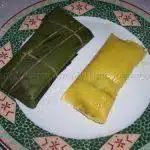
Trinidad Cornmeal Pastelle
Ingredients
- FILLING:
- 1 lb minced beef
- 2 onions finely chopped
- 1 bunch chive
- 1 bunch big leaf thyme
- 1 hot pepper to taste finely chopped
- 1 pimento pepper finely chopped
- 1 stalk celery
- 2 cloves garlic
- 20 leaves chadon beni
- 1 bunch fine leaf thyme
- salt to taste
- ¼ cup roucou or ketchup
- 2 tbsp. capers optional
- 2 tbsp. raisins optional
- 8 olives chopped finely optional
- DOUGH:
- 2 cups yellow cornmeal Promasa
- 3 cups lukewarm water
- 4 tbsp. vegetable oil or coconut oil
- ¼ lb butter unsalted
- 1¼ tsp salt
- Wrapping:
- 2 -3 large fig banana leaves
- Strings to tie
Instructions
- Season the meat. Stew the seasoned meat for 15 minutes. Cook well, then add the roucou or ketchup. Remove from heat and set aside.
- Combine cornmeal, water, salt, and butter to make a soft pliable dough. Divide the dough into small balls (about 12). Cover with damp cloth to prevent drying.
- Cut the fig leaves and strip them from the midrib. Singe the leaf over a low fire on the stove. Wipe clean.
- Grind the green seasoning. Mince the meat again to make it smoother. Combine the seasoning and the meat and place back on the stove. Mix thoroughly and add salt to taste. Allow to cool.
- Dip the ball in the oil. Place on an oiled fig leaf. Use a wooden press to help flatten out the dough. Spoon about 2 tbsp meat filling to the centre of the dough.
- Fold the fig leaf and tie into a neat package using the string. Place in a pot of water and boil for 15-20 minutes. When cooked, drain the water.









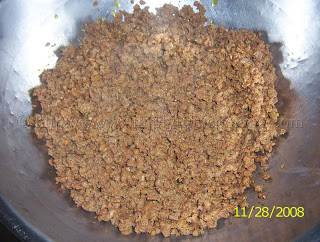
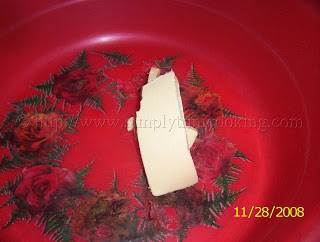

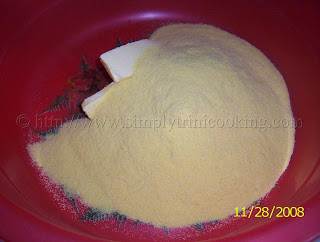
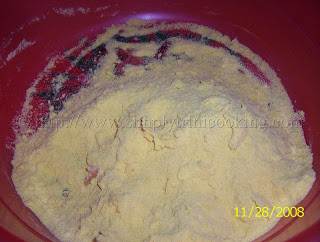











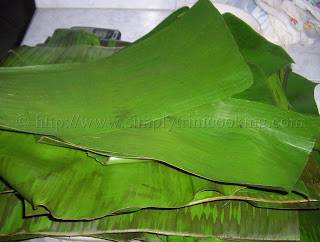

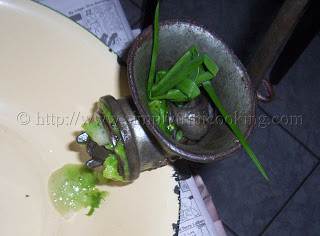





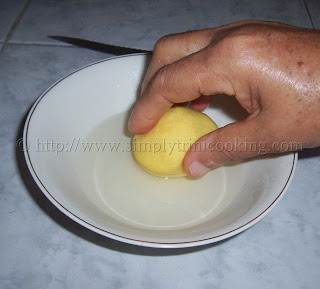








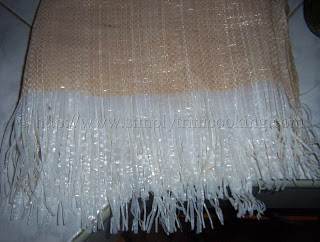




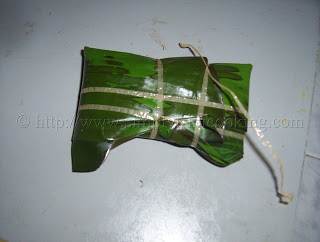

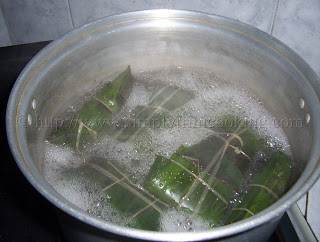


mmmmmmmmm… i can almost taste them! can’t wait to get home for christmas!
thanks for all the good recipes on your blog!
The homemade wooden pastelle press is really interesting gadget! The leaves you used to wrap the pastelle was confused at first as the picture indicated fig leaves not banana leaves…:-D
Another is the Chandon beni, I didn’t know this Saw-toothed Coriander or Culantro can be used in this way as well. Now, I need to hunt for big leaf thyme! Thank yo for sharing such wonderful infos of your local herbs and recipes!
that “green seasoning” looks delish! i look forward to sampling pastelle on a future trip to trini! we have a lot of regional restaurants in houston, but i haven’t seen one offering food inspired by trinidad. Food With Kid Appeal
Thank you Ruth for stopping by. Do come by often and leave a comment it will benefit you. My blog is a do follow.
I recently came across your blog and have been reading along. I thought I would leave my first comment. I don’t know what to say except that I have enjoyed reading. Nice blog. I will keep visiting this blog very often.
Ruth
http://www.infrared-sauna-spot.info
Great post. Very well explained and shown.
I am soo happy to have stumble upon your site. What started out as a search for dhal puri roti recipe, ended up with your awesome blog. I love your step by step and I am going to try every one of your recipes (ingredients permitting) “I’m in heaven” as Frank Sinatra says. P.s. I live in Canada I’m seriously deprived of Caribbean soul food. I look forward to more of your delish morsels.
p.s Interested on your take on coconut choka? ummmmmmm
Greetings.
I moved back to Trinidad a couple of weeks, do want me to take pictures for you, to bring out the taste of your food.
Contact me at
It’s nice to hear from you after such a long time bigbear. It would be nice to get some photo tips from a pro like you.
Hi Deborah, thanks for stopping by. Instead of using fig (banana) leaves you could use foil or parchment paper. Last Sunday I had a fish pastelle wrapped in parchment paper and it was delish.
i really want to try your recipe for cornmeal pastelle. i live in the states so i don’t know where i could buy some fig leaf. i’m wondering if you have an alternative for wrapping them in?
To Deborah…I am not sure where you are in the US, but any Caribbean or Latin/Asian farmers market should sell them. I got mine in the freezer section(imagine that)!. Also for the pastelle press, up here the Latinos would know it as a tortilla press.
OK Online, let me see if I can help. Promasa cornmeal, from experience, mixes well in that the more water you add to it, the stiffer it gets. That’s why we had to put that amount of water. I’m not sure what accounts for that, possibly it’s the starch content or something.
You could try to use less water, pouring a little at a time, to get the same consistency as in the picture; since the cornmeal is different to what I used. Alternatively you can add a little flour to help the dough bind.
Or if you want promasa check out trinifood.com and order online. Lastly according to where you are in the “States” you can check a West Indian market or shop. Hope this helps and Merry Christmas.
Hello:
Actually the Promasa is a corn flour not cornmeal. They are two different things. So it maybe better to point out corn flour as part of the recipe not cornmeal.
Keep up the posts and recipes. Love it!
In Trinidad we have both the Promasa corn flour and corn meal. One is a bright yellow and the other is pretty pale… oh and it says plainly on the package cornmeal/corn flour!
Thanks for your great pictures. I am in the US and use really fine cornmeal (Goya) for my pastels. Yet I can never achieve the firm balls you show; instead mine becomes a wet slurry after mixing with the fat and water. It still comes out okay but makes for a VERY messy process. Any thoughts on this (besides taking a trip down for some Promasa)? 🙂
thanks Lindy for the tip. I’ll go see if I can find those leaves.
Thank you for this really great site which I found while roaming. I am originally a Trini although once one ……… In my very busy life I make pastelles often, flattening with a cast iron tortilla press although I had brought a wooden press with me, and wrapping in parchment as fig leaves are not available. Taste is great and since they are served unwrapped fig leaves are not noticed nor missed, even by my Trini friends. Row
About Promasa, that is masa harina. Row
Hi Row,
Thanks for visiting. Yes, it is a type of masa harina that we use in Trinidad and have come to trust, when it comes to making pastelle. If you check the comments though, some people used different brands of masa and had to experiment a little with measurements.
Hey! thanks so much for the recipe!I’m going to try it next week or so and I’m just wondering is it absolutely necessary to grind the meat? I’m a poor student in London and don’t have a grinder:S only a fairly simple blender
Use what you have 🙂
Thanks Feliz:) I had the same problem as Online though. My dough mixture was too soggy and I had to add more flour to bind it. Then after I steamed it and tried one, the dough was ok but still too soft and not looking as firm and shiny like the award winning pastelles in the picture above:( 🙁
If you can’t get the Promasa you may have to experiment a bit like some of the other comments also check how much butter you use. if you added more flour then you would have to adjust the butter and other ingredients.
Hope you get through with your pastelle. 🙂
oh boy, I tried using pollenta because I can’t get corn meal flour here…soggy is joke. I’ll keep you posted, leeting the mix cool in the fridge overnight. d
You could use masa flour that the mexican uses to make tamales. There tamales is close to our pastelle, you can find it in any major food stores and mexican stores. In the food store you can purchase it for $2.99 U.S. for a 4lb bag this is in the U.S. and the leaves you can also find it in Walmart in the frozen section In the Asian stores and Indian stores and also mexican stores I have seen it in all the above stores. Happy shopping Judy
Hi Felix,
I know it is after xmas but I am making pastelle for the New year I did not have a lot of time to make it before xmas I travel overseas a lot so I did not have a lot of time. I have everything except for spanish time is hard to find it here. And I am using mexican masa flour I will let you know how it turn out today I made the ground meat and the next day I will put it all together thank you for letting me relive my childhood by making my own pastelle!
Similar to the ’empanadas’,
This is NOT a Spanish dish, this is Latin American.
There is a HUGE difference between Spanish dishes i.e from Spain and Latin American dishes i.e primarily based on Native (Latin) American cooking.
Spanish food/dishes refers to that which originated in Europe, NOT Latin America.
The corn alone should tip you off that it’s not a dish with European roots along with the fact that corn was a staple in the Native Latin Americans diet.
A site with so many visitors should atleast make such a correction.
Just my 2c, keep up the good work.
Hi Jackie, thank you for your comment, again. As I explain under your comment for empanadas, Trinidadians, as myself, classify food dishes that have its origins in Latin America or Spain as “Spanish”; it is a cultural norm. Now, I myself have roots from Venezuela, so too are many other Trinidadians. So I am well aware of the origins of the foods such as empanadas and pastelles. I spoke more on this in the article on “The Origins of Parang” (http://simplytrinicooking.com/2010/09/parang-i-origins-of-trinidads-parang.html#axzz1rAo69X5Y). Thank you for your observation. I hope this has thrown some light on this controversial topic.
If anyone else wants to share their thoughts on this topic, feel free to comment.
Thank you sooooooooo much for your recipes, my daughters loved your GHP’s Peanut Butter cookies…(perfect the first time around), pertaining 2 your pastelle recipe I cheated…. time was short so I cut letter sized sheets of foil, placed 5 inch wide strips of banana leaf on the foil, folded edges tightly and boiled it seam side down got and loved the banana leaf infused flavour. Just had to say that u made one trini mom (and daughters) very happy thanks a milllion and one.
Just stumbled upon this site. Excellent recipe ideas. Hoping to try my hand with the coocoo today. Had to go to four different supermarket before I found ochro. Recently moved from New York to Calgary, Alberta, Canada. Anyone coming across this post and live in my neck of the woods please let me know where The West Indin shops are. Thanks a bunch!
Is shadon benny easy to obtain in Ohio?
Love this site! Thank for giving me a chance to make my favourite Christmas dish all the way up in Toronto:)
I’m really impressed with your writing skills as well as with the layout on your weblog. Is this a paid theme or did you customize it yourself? Anyway keep up the excellent quality writing, it is rare to see a great blog like this one nowadays..
Thanks Felix Padilla
The best stuff! Thank you
Great recipe!! Promasa is Colombian 🙂
i like this but never try to make it ,maybe i will try too this Christmas.
I thought it was payme
Tried one made this way, wasn’t a fan, guess i’ll stick to what I know. Spanish style, made with plantains.
These are very good. Quite a project to make but certainly worthwhile during the holidays.
Where to buy a press? Thanks you
hilo
Really! Thank you Jenna.
i want to know if theres a way to heat pastelle up. because there just get so dry when i heat them in the microwave
We usually steam them in a double boiler. A trick for the microwave is to wrap the pastelle in some napkins. That will help retain some of the moisture in the pastelle.
Robertha Paul
Thank you so much
cant wait to try, but i dont have a pastelle press? what can i use instead..and the leave, ive seen them frozen?
What about the paime?
Don’t like PR pastelles, prefer Trini style as that’s what I’m used to. But if I ate 20 more I probably fall in love with them. Don’t give up on ’em Andrea, once u get uses to them you’ll fall too, like any new foods!
Culantro is shadon beni. Ilive in Belize and it is called culantro
What sort of fish do you recommend or use for fish pastelles?
Any firm fish will do.
Sorry, but I learnt the hard way that only Promasa Cornmeal makes great pastelle dough, and another thing, I don’t wait until December to enjoy this delicacy.
I would like to second how pastelles are just like tamales. I have had the experience of making both. I think I might like tamales a little better because you don’t have to be so nice and neat with the dough making the perfectly round balls (unless you NEED it to be photo ready). Maybe you could give us a tamales recipe Felix? I’d like to read your thoughts on the similarities and differences.
I would have to do some research but it seems right up my alley anyhow you take it. I like how it looks indigenous with the corn wrapping.
I not going to bad talk anybody else recipe I’ve seen recently.. but this is the best pastel recipe I’ve come across from the ingredients and the grinding of the meat and the photos. thank you! 🙂